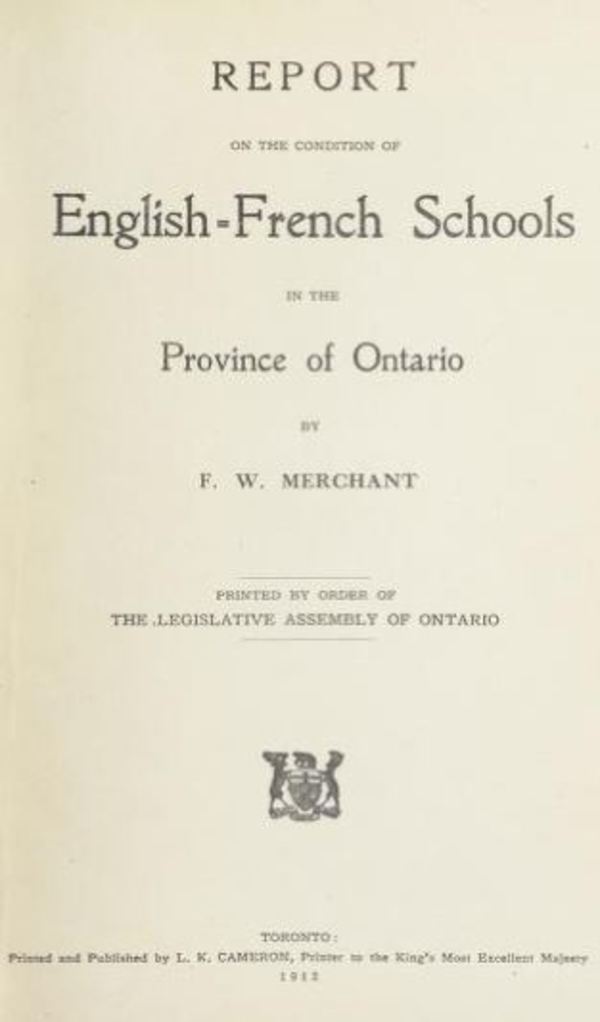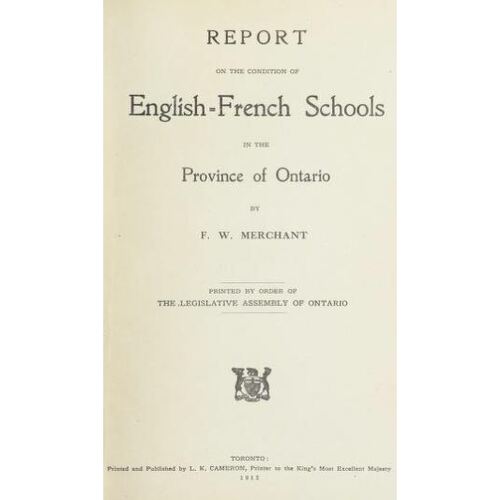
Source: Link
MERCHANT, FRANCIS WALTER, educator, author, and civil servant; b. probably on 25 Nov. 1855 in Oil Springs, Upper Canada, son of Moses Merchant, a farmer, and Mary Miller; m. 23 Dec. 1881 Jean (Jennie) McKay (d. 4 July 1922) in Ingersoll, Ont., and they had two daughters; d. 29 Jan. 1937 in Toronto and was buried there in Mount Pleasant Cemetery.
Francis W. Merchant received his early education in public schools before attending Albert College, a former Methodist seminary that had the power to grant university degrees, in Belleville. There Merchant went to grammar school and then earned a ba (1878) and an ma (1883). A specialist in mathematics and sciences, he rose quickly in the Ontario education system. In 1876, before obtaining his first degree, he had begun teaching high school in Port Dover. After a brief stint at the Ingersoll Collegiate Institute, he returned to Port Dover as the school principal. He then left again, this time to become head of the Ingersoll institution. It was likely in Ingersoll that he met his wife, Jean McKay. Continuing his ascent, Merchant held principalships at the collegiate institutes in Owen Sound (1885–89), Stratford (1889–91), and London (1891–1900) before being named the London Normal School’s first principal. Normal schools were important precursors to teachers’ colleges as places to train high-school graduates as teachers, and the London Normal School was the third such establishment opened in the province. While working there, Merchant earned his phd (1903) in pedagogy from the University of Toronto.
Possessing academic credentials and experience as an educational administrator, Merchant was named Ontario’s chief inspector of public and separate schools and inspector of normal schools in 1908. One of his first reports, completed the following year, assessed the conditions of English-French schools in the Ottawa valley, where he observed that “the atmosphere of the schools is undoubtedly French.” Merchant’s findings were not made public, but his investigation was noticed by Franco-Ontarians, many of whom worried that they would soon face the same educational restrictions imposed on French-speaking minorities in Manitoba [see Thomas Greenway*] and other provinces. “While there is practically no opposition to English,” Merchant noted, “there is a very strong feeling, closely connected with racial, religious, and national sentiment, that the French language must be maintained. Hesitancy in supporting the study of English is frequently the result of the fear that it will eventually lead to the suppression of French.”
Merchant played an important role in the debate over what became known as the Ontario schools question. Irish Roman Catholic bishop Michael Francis Fallon of London sparked French Canadian outrage when he condemned the bilingual schools: in a statement published by the Globe on 17 Oct. 1910, he claimed that the system “teaches neither English nor French, encourages incompetency, gives a prize to hypocrisy and breeds ignorance.” Conservative premier Sir James Pliny Whitney* quickly met with his minister of education, Robert Allan Pyne, as well as the deputy minister of education, Arthur Hugh Urquhart Colquhoun, and the superintendent of education, John Seath*, to discuss the matter. Afterwards Pyne instructed Merchant to look into Fallon’s allegations and prepare a report, thus postponing the bilingual schools issue until after the election of 11 Dec. 1911, when Whitney won his third consecutive majority government.
In his February 1912 report, Merchant observed that “English-French schools are, on the whole, lacking in efficiency.” He pointed to irregular attendance and inadequate teacher-training as contributing factors but stressed that “the bilingual situation presents in itself a problem of special difficulty,” particularly in schools where instruction is given in French at all levels and “English is regarded simply as one subject among others.” On the critical question of whether French-speaking students ought to be educated in English or French, he adopted a moderate position. Like Nova Scotia superintendent of education Alexander Howard MacKay*, whose views are quoted in the report, Merchant favoured making English the sole language of instruction for French-speaking students, but only in the upper levels of study, because “the best results are obtained when the medium of instruction is in the beginning the mother-tongue.” Acknowledging that the timing of the transition to English “depends on the ability of the student and the language conditions of the locality in which the school is situated,” Merchant concluded that, in general, the most satisfactory approach “requires the pupil to remain three years in Form I and two years in Form II, during which time English is made gradually to replace French as the medium of instruction.”
Four months after the Merchant report came out, Pyne issued Regulation 17, which restricted French-language instruction in Ontario to a greater extent than Merchant had recommended. English was made the sole language of instruction beyond the first form (the first two years of study), regardless of local circumstances, and the teaching of French as a subject was sharply proscribed. To enforce the new rules, a more rigid system of inspection was introduced, one that favoured English-speaking instructors.
Merchant avoided being embroiled personally in the controversy that followed the implementation of Regulation 17 [see Napoléon-Antoine Belcourt; Joseph Octave Reaume], in part because he had ceased to be chief inspector of public and separate schools on 30 May 1911, when he was appointed director of industrial and technical education (he remained inspector of normal schools). As director, he was responsible for evaluating the success of the Industrial Education Act of 1911, which had been championed by Seath. Merchant travelled to Europe to examine technical schools there and subsequently added schools and classes throughout Ontario. In 1915 he advised Pyne that returning First World War veterans required more courses to meet their needs and accelerated programs so that they could speedily return to earning wages. Shortly after the war’s end, Merchant was relieved of his post as inspector of normal schools so that he could concentrate fully on industrial and technical education. The federal Technical Education Act and the provincial Adolescent School Attendance Act, both passed in 1919, greatly expanded the scope and scale of Ontario’s technical education, and much of Merchant’s time was spent in evaluating successes and identifying areas where reform was necessary.
In 1923 Merchant, who had received an honorary lld from the University of Toronto two years earlier, was promoted chief director of education. (The position of superintendent, left vacant after Seath’s death in 1919, was thus revived under a different title.) In October 1925 the Conservative premier and minister of education, George Howard Ferguson*, appointed Merchant to head a committee (the other members were judge James Henderson Scott and lawyer Louis Côté) that was tasked with assessing the English-French schools’ efficiency and considering means of improving the training and recruitment of teachers. The committee’s August 1927 report noted that teaching in French had been drastically affected by Regulation 17 and urged, among its suggestions, that “the particular designation, English-French, implying as it does a special type of school with special privileges or restrictions, should be dropped, and all elementary schools … should be placed in either one of the two categories – Public School or Roman Catholic Separate School.” Soon afterwards Ferguson followed the report’s recommendations and ceased to enforce Regulation 17.
Francis Walter Merchant, who turned 75 in November 1930, retired that year from his position as chief director but continued to serve as chief educational adviser to the minister until 1934. He received an honorary lld from the Université d’Ottawa in 1933. In addition to working as an educator and civil servant, Merchant published several textbooks for use in Ontario schools and served on the University of Toronto’s board of governors. He died in Toronto on 29 Jan. 1937 after suffering a coronary thrombosis. At his funeral, Ferguson declared that Merchant was “the father of the vocational training system” and “the greatest educationist we’ve had in Ontario since [Egerton Ryerson*],” while University of Toronto president Henry John Cody*, who had been minister of education in 1918–19, judged that “no one has had a wider and more thorough grasp of the whole educational system in Ontario.” Though Merchant is most often remembered for his reports on bilingual schools, his long career should be recognized also for his distinguished contribution to many parts of the province’s educational system, especially his championing of vocational and normal schools.
Francis Walter Merchant is the author of “The Ontario examination system” (d.paed. thesis, Univ. of Toronto, 1903); the Report on English-French schools [in the Ottawa Valley] ([Toronto], 1909); and the Report on the condition of English-French schools in the province of Ontario (Toronto, 1912). He is a contributor to the report published in Toronto in 1927 by the Committee appointed to enquire into the condition of the schools attended by French-speaking pupils. Merchant is also the author or co-author of the textbooks High school physical science (2pts., Toronto, 1895–96); Supplement to high school physical science (Toronto, 1899); and Mechanics for the upper school (Toronto, 1919).
AO, RG 2-102. Le Droit (Ottawa), 13 Nov. 1950: 3. Globe, 17 Oct., 12 Nov. 1910. Globe and Mail, 1, 5 Feb. 1937. Toronto Daily Star, 1 Feb. 1937. Marilyn Barber, “The Ontario bilingual schools issue: sources of conflict,” CHR, 47 (1966): 227–48. Canada’s Historic Places, “The Canadian register,” London Normal School: www.historicplaces.ca/en/pages/about-apropos.aspx (consulted 8 Nov. 2017). Canadian album: men of Canada, or success by example …, ed. W[illia]m Cochrane (5v., Brantford, Ont., 1891–96), 1: 460. Gaétan Gervais, “Le Règlement XVII (1912–1927),” Rev. du Nouvel-Ontario (Sudbury, Ont.), 18 (1996): 123–92. R. [S.] Harris, Quiet revolution: a study of the educational system of Ontario (Toronto and Buffalo, N.Y., 1967). Françoise Noël, “The impact of Regulation 17 on the study of district schools: some methodological considerations,” Hist. Studies in Education (Toronto), 24 (2012), no.1: 72–92. Ont., Dept. of Education, Report of the minister of education, 1912–27, 1936; Royal commission on education in Ontario, Report (Toronto, 1950). Margaret Prang, “Clerics, politicians, and the bilingual schools issue in Ontario, 1910–1917,” CHR, 41 (1960): 281–307. S. J. Rogers, “The organization, control and administration of the teacher training system of the province of Ontario: 1900–1920” (phd thesis, Univ. of Ottawa, 1972). O. D. Skelton, The language issue in Canada (Kingston, Ont., 1917). Univ. of Toronto, Report of the board of governors for the year ended 30th June 1936 (Toronto), 1937.
Cite This Article
Geoff Keelan, “MERCHANT, FRANCIS WALTER,” in Dictionary of Canadian Biography, vol. 16, University of Toronto/Université Laval, 2003–, accessed April 29, 2025, https://www.biographi.ca/en/bio/merchant_francis_walter_16E.html.
The citation above shows the format for footnotes and endnotes according to the Chicago manual of style (16th edition). Information to be used in other citation formats:
| Permalink: | https://www.biographi.ca/en/bio/merchant_francis_walter_16E.html |
| Author of Article: | Geoff Keelan |
| Title of Article: | MERCHANT, FRANCIS WALTER |
| Publication Name: | Dictionary of Canadian Biography, vol. 16 |
| Publisher: | University of Toronto/Université Laval |
| Year of revision: | 2024 |
| Access Date: | April 29, 2025 |



